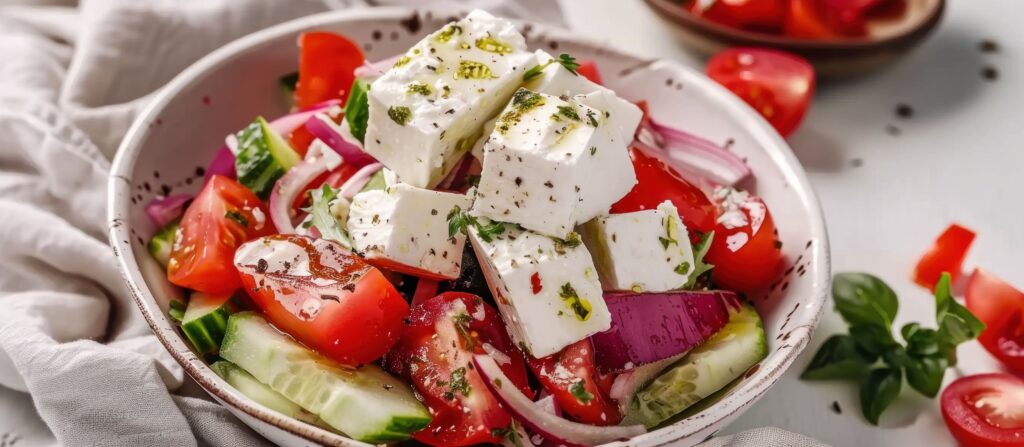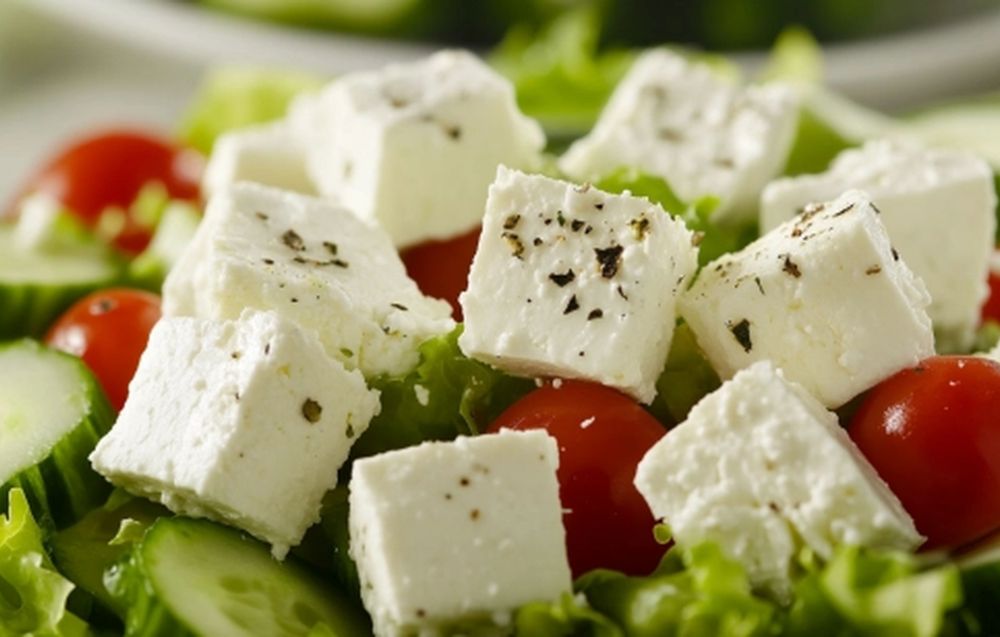Let’s talk cheese! Specifically, feta cheese—the crumbly, tangy delight that’s a staple in Mediterranean cuisine. But is feta cheese healthy, or is it better left off your plate? Packed with nutrients like calcium, protein, and probiotics, it offers some impressive health benefits. However, its high sodium and saturated fat content might make you pause. Whether you’re tossing it into a salad, crumbling it over roasted vegetables, or using it in a dip, feta can add bold flavor to your meals. In this article, we’ll explore the facts and help you decide if feta deserves a spot in your healthy diet.
Understanding Feta Cheese
What Makes Feta Cheese Unique?
Feta stands out from the cheese crowd for its salty tang and soft, crumbly texture. Made primarily from sheep’s milk (or sometimes a mix of sheep and goat’s milk), traditional Greek feta goes through a brining process that locks in its signature flavor.
If you’re looking to understand more about how feta fits into balanced nutrition, you might want to explore feta cheese nutrition: smart eating made easy for deeper insights.
Traditional vs. Modern Feta: Differences and Similarities
The feta you eat today may not be the same as it was a hundred years ago. Traditional feta is raw and unpasteurized, offering a richer flavor and a more authentic experience. Modern feta, for safety and accessibility, is often pasteurized and may even include cow’s milk, which can alter its taste and texture slightly. If you’re wondering, is feta cheese healthy, the production method and ingredients can play a role in its nutritional value and flavor profile, making it essential to choose high-quality feta for the best health benefits and taste.
For a better understanding of feta’s versatility in recipes, check out these helpful ideas: easy pistachio cream: love at first taste.
Varieties of Feta Cheese Around the World
While Greek feta is the classic, other countries have their takes. Bulgarian feta is saltier, while French feta is creamier and less tangy. Exploring these can add unique flavors to your dishes.
If you’re curious about pairing feta with other foods, this guide to best cheeses for mac and cheese can spark some creative ideas.

Nutritional Insights of Feta Cheese
Here’s the million-dollar question: is feta cheese actually good for you? Let’s break it down.
Key Nutrients in Feta Cheese
Feta is packed with nutrients in a small serving size. In just 1 ounce (28 grams), you get:
- Calories: 75
- Protein: 4 grams
- Fat: 6 grams (mostly saturated fat)
- Calcium: 14% of the Daily Value (DV)
- Sodium: 13% of the DV
With its high calcium and protein content, feta can be a nutritional powerhouse.
The Caloric Breakdown of Feta Cheese
At just 75 calories per ounce, feta is a lighter choice compared to heavier cheeses like cheddar. But don’t let its low calorie count fool you; feta’s salty punch means a little goes a long way in adding flavor. If you’re wondering, is feta cheese healthy? Its lower calorie content and bold flavor make it a great option for those seeking a lighter yet satisfying addition to meals.
Feta Cheese and Its Role in Balanced Nutrition
Pairing feta with nutrient-rich foods like leafy greens, nuts, or whole grains can create a well-rounded dish. Want inspiration? This article on easy protein granola might give you an idea of how to include feta in a balanced meal.
Health Advantages of Feta Cheese
Bone Health Benefits of Feta Cheese
Thanks to its high calcium content, feta is a boon for bone health. It helps prevent conditions like osteoporosis, making it a great option for anyone concerned about aging gracefully. Is feta cheese healthy? Its calcium-rich profile and bone-strengthening benefits certainly make a strong case for including it in your diet.
Boosting Immunity with Probiotics in Feta
The probiotics in feta don’t just support your gut health—they also boost your immune system. Think of probiotics as the friendly bacteria that keep harmful invaders in check. Is feta cheese healthy? Its probiotic content contributes to both digestive and immune health, adding another reason to enjoy this flavorful cheese.
Antioxidant Properties in Feta Cheese
Feta contains small amounts of antioxidants, which can help reduce inflammation and protect your cells from damage. Combining feta with antioxidant-rich foods like tomatoes or olives is a flavor-packed way to double down on health benefits. Is feta cheese healthy? Its antioxidant properties, paired with nutrient-rich companions, make it a smart and delicious choice for your meals.
Block Quote: A Flavorful Perspective
“Feta cheese is more than just a topping—it’s a versatile ingredient that can turn any meal into a Mediterranean masterpiece.”
Potential Risks and Drawbacks of Feta Cheese
While feta cheese offers many health benefits, it’s not without its downsides. Overindulgence or certain dietary sensitivities can make it less suitable for everyone. Let’s take a closer look at the potential risks and how to address them.
The Sodium Challenge: How Much is Too Much?
One of the most significant drawbacks of feta cheese is its high sodium content. In just a 1-ounce serving, you get about 312 milligrams of sodium, roughly 13% of the recommended daily intake. For those watching their salt levels, like individuals with hypertension or heart disease, this can be a concern.
Reducing sodium doesn’t mean giving up feta altogether. Consider these tips:
- Soak feta in water for 10–15 minutes to reduce its saltiness.
- Pair it with low-sodium foods like fresh vegetables.
- Use it sparingly, focusing on its strong flavor to enhance a dish rather than dominate it.
If you want to learn more about managing sodium intake, check out this helpful guide on tips for reducing sodium intake.
Lactose Intolerance and Dairy Allergies
Feta is lower in lactose compared to many other cheeses, making it easier for some people with mild lactose intolerance to digest. However, it still contains some lactose, so if you’re severely intolerant, it might not be the best choice.
For those with dairy allergies, feta cheese can trigger allergic reactions, as it’s made from sheep’s or goat’s milk. If that’s the case, plant-based alternatives like almond or cashew-based cheeses might be a better fit.
Saturated Fat: Friend or Foe?
Feta cheese contains about 4 grams of saturated fat per ounce. While saturated fat has long been vilified, recent research suggests that moderate consumption, especially from natural sources like dairy, isn’t as harmful as once thought.
For a more heart-healthy option, consider balancing feta with healthy fats like olive oil or nuts, which are staples of the Mediterranean diet. Curious about this eating style? Dive into the Mediterranean diet health benefits to see how it could work for you.
Delicious Pairing Ideas with Feta Cheese
The beauty of feta lies in its versatility. It’s a culinary chameleon, effortlessly adapting to a variety of dishes. Here are some fantastic pairing ideas to make the most of its tangy flavor.
Fresh Salads and Feta Cheese
Feta adds a burst of tanginess to salads, making it a favorite in classics like Greek salad. Pair it with cucumbers, tomatoes, red onions, olives, and a drizzle of olive oil for a refreshing, nutrient-packed dish.
For a twist, toss crumbled feta into a quinoa salad with fresh mint and pomegranate seeds. The combination of sweet and salty flavors is simply irresistible.
Feta in Warm Dishes
Feta isn’t just for cold dishes—it shines in warm meals too! Add it to:
- Roasted Vegetables: Sprinkle feta over roasted zucchini, bell peppers, or eggplant for a Mediterranean flair.
- Baked Casseroles: Use feta in spinach and feta pies or baked pasta dishes.
- Soups: Crumble it into tomato or lentil soup for a creamy, tangy finish.
If you’re a fan of fermented foods, feta pairs beautifully with other tangy ingredients. Read more about nutritional benefits of fermented foods to discover how they can elevate your meals.
Feta as a Snack or Spread
Need a quick snack? Combine feta with yogurt and fresh herbs to create a creamy, flavorful spread that’s perfect for pairing with whole-grain crackers or crunchy veggie sticks. This simple and satisfying option is both delicious and nutritious, adding variety to your snacking routine.
For something unique, try serving feta with honey and walnuts for a savory-sweet appetizer that’s sure to impress. This combination not only highlights the tangy, salty flavor of feta but also provides a touch of sweetness and crunch. It’s a great way to enjoy a feta cheese healthy snack while keeping things balanced and satisfying.
How Feta Fits Into Different Diets
Feta cheese can align with various diets, but its compatibility depends on your health goals and dietary restrictions. Here’s a closer look at how it fits into some popular eating plans.
Feta Cheese in the Mediterranean Diet
As a cornerstone of the Mediterranean diet, feta cheese is a prime example of how simple, natural foods can be both nutritious and flavorful. Is feta cheese healthy? This diet emphasizes whole foods like fruits, vegetables, nuts, legumes, and healthy fats, with moderate dairy consumption, making feta a perfect fit for its balance of taste and health benefits.
Feta’s probiotic content and calcium levels make it a great addition to this diet.
Is Feta Cheese Keto-Friendly?
The ketogenic diet focuses on high-fat, low-carb foods, and feta fits the bill perfectly. Is feta cheese healthy? With just 1 gram of carbohydrates per ounce, feta is not only keto-friendly but also a flavorful way to incorporate healthy fats into your meals while keeping carbs low.
Pair feta with avocado slices, drizzle with olive oil, and sprinkle with black pepper for a quick and satisfying keto snack.
Feta for Vegetarians and Vegans
Vegetarians can easily enjoy feta as part of their diet, but vegans, unfortunately, cannot, as it’s a dairy product. However, plant-based alternatives made from nuts can mimic feta’s crumbly texture and tangy flavor. Look for almond or cashew-based “feta” at your local store or try making your own.
Feta for Bone Health
Calcium plays a crucial role in maintaining bone density, and feta delivers a healthy dose in every serving. Pair it with other calcium-rich foods like kale or almonds for a bone-friendly meal.
Block Quote: Why Moderation Matters
“Feta cheese isn’t just an ingredient; it’s a reminder that eating well can also mean eating deliciously. Moderation is key—let feta enhance your dishes without overwhelming them.”
Expert Opinions on Feta Cheese
When it comes to understanding the health implications of feta cheese, hearing from experts can provide clarity. Is feta cheese healthy? Nutritionists and researchers often highlight its benefits, such as calcium and probiotics, while stressing the importance of balance and moderation, particularly due to its sodium and saturated fat content.
What Nutritionists Say About Feta Cheese
Nutritionists generally agree that feta cheese can be a valuable addition to a healthy diet. Is feta cheese healthy? Its high calcium content supports bone health, while its rich probiotics benefit gut health. However, they caution against overconsumption due to its sodium and saturated fat levels, emphasizing moderation for a balanced approach.
For instance, many dietitians recommend using feta as a garnish or an accent rather than a primary ingredient. This approach allows you to enjoy its bold flavor without consuming excessive amounts of salt or fat. Pairing feta with fresh vegetables, whole grains, and healthy fats can help balance its nutritional profile.
How Feta Fits Into a Balanced Diet
According to dietary guidelines, moderation is key when enjoying cheese, including feta. Experts suggest limiting total cheese consumption to about 1.5 to 2 ounces per day. This is enough to enjoy the benefits without overloading on calories, fat, or sodium.
Feta’s strong flavor works to your advantage here—you don’t need much to make an impact. A sprinkle of crumbled feta over a salad or a small cube added to a vegetable skewer can go a long way.
Scientific Studies on Feta Cheese and Health
Science backs many of the health claims about feta cheese, particularly its role in bone health and gut health. Here are some key findings from recent research.
The Role of Probiotics in Gut Health
One standout benefit of feta cheese is its probiotic content. Probiotics are beneficial bacteria that help maintain a healthy gut microbiome. A healthy gut is linked to improved digestion, better immune function, and even mental health benefits.
Studies show that fermented foods like feta cheese can introduce probiotics into your diet. These live microorganisms can aid in breaking down food, absorbing nutrients, and preventing harmful bacteria from taking over.
Calcium and Bone Health
Feta cheese is a calcium powerhouse, and research consistently highlights calcium’s critical role in maintaining strong bones and preventing osteoporosis. The phosphorus in feta also works synergistically with calcium to enhance bone mineral density. Is feta cheese healthy? Its impressive calcium and phosphorus content makes it an excellent choice for supporting bone health and overall well-being.
For people who struggle to meet their daily calcium needs, incorporating small amounts of feta into meals can be a delicious and practical solution. However, experts suggest balancing it with other calcium-rich foods like yogurt, almonds, or leafy greens for maximum benefit.
Antioxidants in Feta Cheese
Feta cheese contains small amounts of antioxidants, which help neutralize free radicals in the body. Free radicals are unstable molecules that can cause oxidative stress, leading to inflammation and chronic diseases.
While feta’s antioxidant levels aren’t as high as those found in fruits or vegetables, every bit contributes to an overall balanced diet. Combining feta with antioxidant-rich foods like tomatoes or spinach can amplify these benefits.
Frequently Asked Questions About Feta Cheese
Still have lingering questions about feta cheese? Let’s address some of the most common queries to help you make informed choices.
Is Feta Cheese Better Than Other Cheeses?
It depends on your dietary needs. Feta cheese is lower in calories and fat compared to many other cheeses like cheddar or gouda. It’s also higher in probiotics and easier to digest for people with mild lactose intolerance.
However, its high sodium content may be a drawback for individuals who need to monitor their salt intake. If you’re looking for a flavorful, nutrient-dense cheese in moderation, feta is an excellent choice.
Can Feta Cheese Help With Weight Loss?
Yes, but with a caveat. Feta cheese is relatively low in calories, which can make it a good addition to a calorie-controlled diet. Its high protein content can also promote satiety, helping you feel full longer.
However, its sodium content could lead to water retention, temporarily masking weight loss. The key is to use feta sparingly as a flavor enhancer in healthy dishes like salads, grain bowls, or roasted vegetables.
How Much Feta Cheese Can I Eat in a Day?
Most dietary guidelines suggest limiting cheese intake to around 1.5 to 2 ounces per day. For feta, this translates to approximately 2–3 small cubes or a generous sprinkling of crumbles.
Eating more than this occasionally isn’t likely to harm you, but regular overconsumption can contribute to excess sodium and fat intake.
Is Feta Cheese Suitable for Children?
Yes, but in moderation. Feta cheese can be a nutritious addition to a child’s diet, providing calcium and protein for growth and development. However, its high sodium content means it’s best to limit the amount given to young children.
For toddlers, try mixing small amounts of crumbled feta into pasta or mashed vegetables to introduce them to the flavor without overwhelming their palate.
Can Feta Cheese Be Frozen?
Technically, yes, feta cheese can be frozen, but it’s not always ideal. Freezing can change its texture, making it crumblier and slightly grainy when thawed. If you plan to freeze feta, use it in cooked dishes like casseroles or soups rather than as a fresh garnish. While considering is feta cheese healthy, it’s worth noting that freezing doesn’t significantly impact its nutritional benefits, such as calcium and probiotic content, making it a convenient option for long-term storage.
Block Quote: The Final Word on Feta Cheese
“Feta cheese strikes a balance between flavor and nutrition. With its tangy taste and nutrient-rich profile, it’s a smart choice for those who want to eat healthily without sacrificing taste.”
Wrapping It Up: Is Feta Cheese Healthy for You?
The answer to this question depends on your individual health goals and dietary needs. Is feta cheese healthy? It’s undeniably packed with benefits, from its calcium and probiotic content to its low-calorie profile. However, its high sodium and saturated fat levels mean it’s best enjoyed in moderation to balance its nutritional advantages.
Think of feta as a flavorful tool in your culinary arsenal. Whether you’re sprinkling it on a salad, blending it into a dip, or baking it into a casserole, it can elevate your dishes and contribute to a balanced diet.
By using it wisely and pairing it with nutrient-dense ingredients, you can savor all that feta cheese has to offer without compromising your health.

